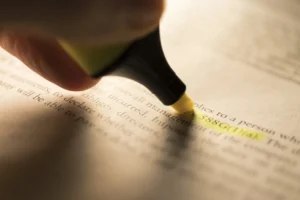KPA Lawyers – December 15, 2020
Book a call with a civil lawyer here.
So what can you do if you’re worried about a defendant getting rid of their money or their assets while you are waiting for your civil case to be completed in Ontario?
After all, it doesn’t make any sense to go through all the trouble of suing somebody just to have them get rid of all of their assets during the lawsuit, and then there’s nothing left after you win your case.
It’s probably no surprise that this issue comes up fairly frequently in our justice system, so there is a formal process for dealing with situations like that.
If you’re the Plaintiff or the Applicant in the lawsuit, you might want to ask a judge to issue a court order called a Mareva Injunction or also called a Mareva Order.
I’ll go into more detail about how these types of court orders work, but before we I do that, I should mention that you can’t get a Mareva Injunction in Small Claims Court. So, rather than hiring a paralegal, you’ll be using a lawyer and the case will go to Superior Court. Technically speaking, the Small Claims Court is a branch of the Superior Court, but they’re treated as very different places, and one of the differences that are relevant to this video is that you can’t get a Mareva Injunction in Small Claims Court.
Okay, so, what does a Mareva Order do and how do you get one?
So in plain English, a Mareva Order is an asset freezing order that primarily stops someone from doing either of the following two things:
1) taking their money or assets out of the jurisdiction
2) dissipating their assets, like going and spending it all at the casino or something.
Oftentimes, Defendants can get really sneaky by thinking that if they don’t own any money or assets, then even if they lose the lawsuit, there won’t be any real consequences because they will have made themselves what’s called “judgment proofâ€, so the idea behind the Mareva Injunction is you’re trying to stop the Defendant from making themselves judgment proof.
One thing worth mentioning here is just because a Mareva Order is issued doesn’t necessarily mean that will effectively stop the Defendant from doing what they’re trying to do. So, let’s say you get a Mareva Order requiring someone not to sell their house until a particular lawsuit against them has been completed, well, they could still go ahead and sell their house, but the only difference would be that they could be held in contempt of court and potentially have to serve jail time for that. So, usually, the threat of jail is enough for most people to comply with the Mareva Order.
It’s important to keep in mind that under the law, Judges will sort of default into the point of view that the Defendant’s assets should not be frozen, unless the Plaintiff can establish all of the exact legal grounds to convince the Judge otherwise. This general rule is because freezing someone’s assets is a very serious restriction on their rights, especially since they haven’t even lost their case yet, and the other reason is the potential for Plaintiff’s to sort of use the Mareva Order to pressure the Defendant into settling the case just so they can get control of their assets back.
Another interesting thing about these very unique kinds of court orders is you can actually get them without involving the Defendant and without even putting the Defendant on notice that your lawyer is going to be bringing this kind of motion. This is called an ex parte hearing, where you’re basically making your case to the judge without the other party even being there.
That might seem a bit unfair to the Defendant, but you have to keep in mind that the order will only be valid for usually 10 days until you have to have another meeting with the Judge to extend the Order for a longer period of time, and that second meeting will involve the Defendant.
The idea here is simple, if you give someone advanced noticed that you’re trying to freeze their assets, that will only motivate them to move or dissipate their assets even faster. That wouldn’t make a lot of sense. So there are very logical reasons why the justice system allows you to get this court order, at least for a short period of time, without any warning to the Defendant.
So let’s take a deeper dive into what the Plaintiff has to show the Judge in order to successfully obtain a mareva injunction.
Seven-part test
There are actually seven things that the Plaintiff has to establish, so it’s not exactly a short list here. Whenever anyone in a lawsuit has to prove a list of specific points, the law refers to that as “meeting the test†for something. So in this case, the seven things that the Plaintiff or Applicant has to prove is called the “test for a Mareva Orderâ€.
So, the first part of the test is pretty straightforward. The Plaintiff has to provide details, or what’s known as “particularsâ€, of their legal claim against the Defendant. This is basically an explanation of the circumstances surrounding why the Plaintiff sued the Defendant.
The second part of the test is for the Plaintiff to demonstrate the merits of their case. This is slightly different from the first part, because you’re not just explaining your side of the story, but you’re actually producing some kind of evidence to show that your case has merit.
The third part of the test is to explain to the Judge why you think the Defendant even owns assets within the jurisdiction, they might not actually own anything for all you know. However, let’s say you suspect that the Defendant owns a house, and you think you know the address, but you’re aren’t 100 percent sure. What you can do, in that case, is talk to a real estate lawyer or a civil lawyer about getting something called a Parcel Register for that house, which is a government document that will verify the ownership of the home. So that’s one way you can prove that the Defendant actually owns assets within the jurisdiction.
The fourth part of the test requires the Plaintiff to show that there is a real risk that at least one of the following two things will happen:
1) that the Defendant is removing or will remove assets from the jurisdiction or
2 ) the Defendant will dissipate their assets.
In other words, it’s not enough to show that the Defendant has assets, you have to actually show that there is a real risk that those assets are not going to be available to the Plaintiff even if the Plaintiff wins their case later on down the road. For example, you could show that the Defendant listed their house on MLS to show that they were in the process of liquidating their real estate assets.
The fifth part of the test is that the Plaintiff or Applicant will have to convince the Judge that the Plaintiff will suffer “irreparable harm†if the Mareva Injunction is not granted. This one seems pretty obvious, the idea here is that the judge has to consider the harm that would be done to the Plaintiff if the Mareva Order is not granted. And there might be some cases where the Judge things that the Plaintiff might be inconvenienced but not necessarily irreparably harmed, so that very precise detail would have to be decided on a case by case basis.
The sixth part of the test is a bit more complicated in terms of how it’s worded, and it basically says this. The Plaintiff has to show that the “balance of convenience†favours the Plaintiff rather than the Defendant. That’s obviously a fancy legal term, but what does it actually mean? Well, it’s easiest to think of it like this. There’s only going to be one of two possible outcomes: either the Judge grants the Mareva Order, or they don’t. So the balance of convenience is basically asking who will suffer the greater harm in both possible outcomes. If the Judge says no, we’re not freezing any assets here, and let’s say the harm to the Plaintiff in that outcome on a scale of 1 to 10 is a 4, but on the other hand, if the Judge says yes, we’re going to freeze the Defendant’s assets, and the harm done to the Defendant with that outcome is a 9, then the Judge might end up rejecting the Mareva Order. Now that might be an oversimplification, but it’s basically just meant to explain the meaning of the term “balance of convenience†in as simple language as possible.
The seventh and final part of the test is the one that gives Plaintiffs the most goosebumps and is easily the most uncomfortable part of the test for the Plaintiff.
The Plaintiff basically has to swear an affidavit that the Plaintiff will pay money to the Defendant if it is later determined that granting the Mareva Injunction was not warranted and caused harm to the Defendant. As you can imagine, this is a bit of a gamble for the Plaintiff. Sure, the Plaintiff gets to freeze the Defendant’s assets during the lawsuit, but let’s say that the Defendant eventually wins the lawsuit, or even if they don’t win, if they’re able to prove that the injunction was not warranted, the whole injunction could end up backfiring on the Plaintiff. So, basically, if you’re going to ask your lawyer to try to get a Mareva Injunction against somebody, you and your lawyer should be absolutely convinced that the injunction is actually warranted, because it can end up having very bad financial consequences to the Plaintiff if they are over aggressively getting these kinds of injunctions.
Remember, this article is not intended as legal advice, and if you want to actually get an asset freezing order, you should talk to a lawyer who knows how Mareva injunctions work and how they are properly obtained in court.



